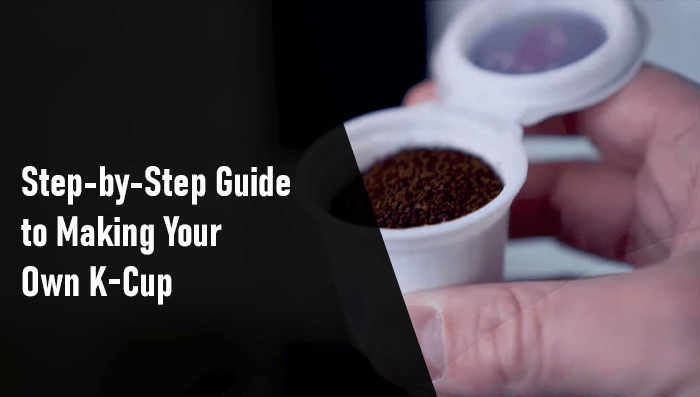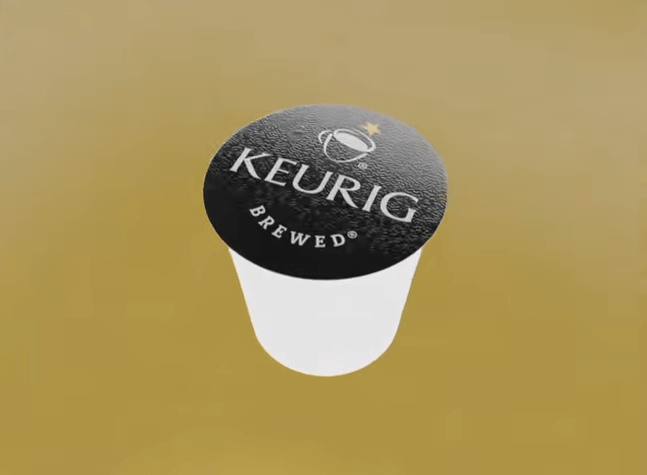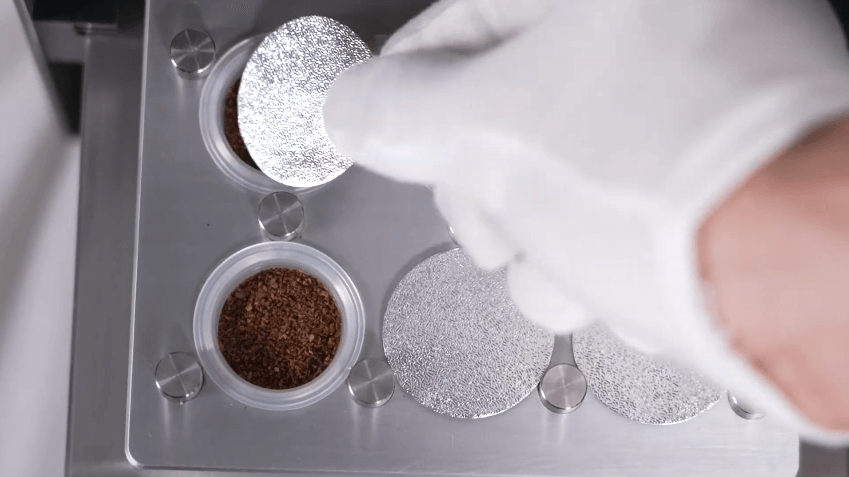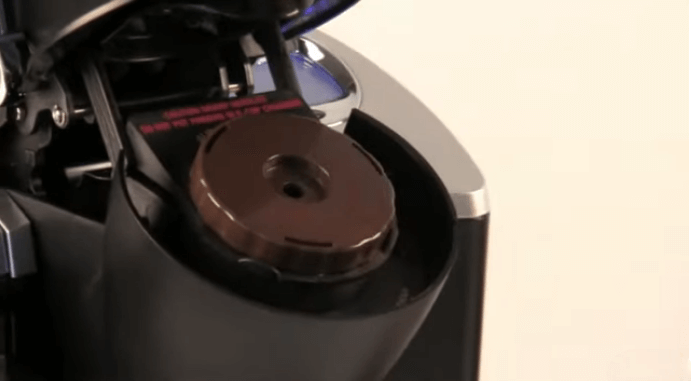Step-by-Step Guide to Making Your Own K-Cup

Do you want to avoid constantly running out of your favorite K-Cups or paying a premium at the store? Did you know that you can easily make your own at home? That’s right, and in this step-by-step guide on making your own K-cup, we’ll show you just how easy it is. So, let’s get started!
For making A DIY K-cup, you only need three things: a used K-cup, a square piece of aluminum foil, and filter paper. First, empty the coffee grounds of your previously used K-pod. Now clean the cup, fill half with your favorite ground mix, and seal the cup with aluminum foil.
Don’t think that’s it, because there is more to it. So, keep reading for a detailed guide.
Can I Make My Own K-cup?
Definitely! Making your own K-Cup is a breeze; the best part is that you have complete control over the quality of your coffee. It’s the best way to save money and the earth from single-use plastic.

Moreover, you get to choose the type of coffee beans, the roast, and the grind size. Hence, you can experiment with different coffee grinds and ingredients to create a unique blend according to your liking. So why not give it a try? With time and effort, you can be sipping on a perfectly brewed cup of coffee just the way you like it!
Step By Step Guide To Make DIY K-cup?
Without further ado, let’s move on to the step-by-step guide to making your own K-cup. Follow each step with enough care and precision to have a budget-friendly solution.
Gather The Ingredients:
Before making your own K-Cups, you’ll need to gather a few essential materials. You’ll need
- A reusable K-Cup
- Coffee beans
- According to your choices, additional ingredients include milk, sugar, cocoa powder, or cinnamon.
- A coffee grinder or any regular grinder is available in your kitchen.
Preparing The Coffee Grounds:
The first step is to prepare the coffee grounds. Since everyone has different likings for their coffee, I suggest adjusting the grind size based on your taste preference. Grind the beans in fine powder and test it with your Keurig.

If the coffee turns out to be more acidic, try a thicker grind. However, if it turns out bitter, try a finer powder. So, grind the coffee beans to the desired size and texture for brewing.
Filling The Reusable K-Cup:
Once your coffee grounds are ready, it’s time to fill the reusable K-Cup. Fill the quarter K-cup with the coffee grounds. Add any additional ingredients you want to use.

Never fill the cup partially; you must leave room for water. Ensure to pack the coffee grounds firmly, but not too tightly, so that water can flow through the grounds quickly.
Sealing the K-Cup:
Next, it’s time to seal the K-Cup. It is an important step to ensure that the K-Cup doesn’t overflow during brewing. Cut a Paper filter or aluminum foil into equal squares of about 2 inches.

Now cover the cup and fix it with a rubber band tightly. Ensure the lid is securely in place and the seal is tight.
Brewing The Homemade K-Cup:
Now that your K-Cup is filled and sealed, it’s time to brew! Place the K-Cup into your Keurig machine and select your desired cup size.

The device will do the rest. And you’ll have a delicious, fresh cup of coffee in just a few minutes.
Cleaning And Maintenance:
It’s important to clean your k-cup regularly to ensure it stays in good condition and works properly. Simply hand wash the K-Cup with warm soapy water, rinse it well, and let it air dry. Only reuse a cup at most five times to avoid over usage.
Will DIY K-Cup Fit All Keurig?
The good news is that many reusable K-Cups are designed to fit most Keurig machines. However, buying K-cups compatible with your Keurig model and re-using them is always a good idea.
It’s important because some older Keurig models may not be compatible with certain reusable K-Cups. Besides, if you’re using an older machine, you should check the compatibility before purchasing a reusable K-Cup.
Pros And Cons Of Making a DIY K-cup?
I am sure you are thinking about making your own keyword, but wait a minute. Here’s a quick rundown of the pros and cons of making your own K-Cup.
Pros | Cons |
|
|
|
|
|
|
|
Tips for Brewing the Perfect Cup of Coffee With a DIY K-Cup:
Some coffee lovers think a DIY k-cup cannot taste different from a prepackaged cup. Well, that’s not true because a few test cups can result in a budget-friendly perfect cup of hot coffee. Therefore I am here to give golden tips for brewing perfect cups.
- Always get your favorite coffee ground or ask the retailer for Arabica coffee.
- Place the DIY k-cup, considering making sure the needle is co-inside with the last hole.
- Add some cinnamon for enhanced flavor.
- Run the coffee beans twice in the grinder for a medium-fine powder that gives a perfect taste.
- Only fill the cup quarter for a balanced brew.
- Pack the grind in the cup moderately because that can fail the power pressure technique.
Best Replacements For K-cups:
If you’re looking for ways to reduce your environmental impact and save money, you might consider alternatives to disposable K-cups. Fortunately, there are plenty of options out there that are both eco-friendly and budget-friendly. So, let’s discover how you can drink your coffee while doing your part for the planet.
Reusable K-Cups:
It’s a perfect alternative to the Keurig k-cup. Neither do you have to put your time into making DIY cups nor purchase the pre-packaged cups to be reused? You just need a coffee mix to fill the cup and seal it. And you will have a perfect brew with only five minutes of effort.
Coffee Pods:
These are similar to K-Cups but are made from compostable materials such as paper or plant-based plastics. Besides, they have a built-in filter and a variety of coffee blend options to choose from.
Pour Over Coffee Maker:
It’s a simple and inexpensive method. You just need to pour hot water over your coffee grounds, and your coffee will be ready. Pour-over coffee makers allow you to control the brewing process and customize your cup of coffee.
Keurig My Cup Adapter:
It’s my favorite alternative to traditional k-cups. It’s a reusable k-cup with a robust filter that only needs cleaning after every use. It’s cheaper and reduces a lot of single-use plastic dumped on earth. Just clean the filter and fill it with your customized coffee blend to enjoy a perfect brew.
Final Words:
Making your own K-Cups is a simple, budget-friendly way to enjoy your favorite coffee at home. With just a few basic materials and a little time, you can create customized K-Cups and enjoy a delicious cup of coffee whenever you like. So give it a try and see what you can make!
FAQs:
Can I Open K-cups And Use Them In A Regular Coffee Maker?
Unfortunately, you can’t use a K-Cup in a regular coffee maker. K-Cups are explicitly designed for Keurig coffee makers with a unique brewing system puncturing the cup and extracting the coffee. Traditional coffee makers don’t have this capability, so you won’t be able to use a K-Cup in one.
Is DIY k-Cups Budget-Friendly?
We know that pre-packaged K-Cups can cost anywhere from 50 cents to a dollar each. When you have the reusable K-Cup, you only need to buy the coffee beans and any additional ingredients you want to use. So, if you’re a daily coffee drinker, making your own K-Cups is the most budget-friendly option because it reduces the price by up to half of the pre-packaged cup.
Can you put your coffee blend in a K-cup?
Yes, you can definitely put your coffee blend in a K-Cup! That’s the whole point of making your own K-Cups – you get to choose the type and strength of coffee you want. It’s the best way to have a perfectly brewed cup of your own custom coffee blend. Making your own K-Cups allows you to be creative and try new combinations, and it also helps reduce waste and save money in the long run.
Are K-cups basically instant coffee?
Well, that’s a matter of opinion. Some might say that K-Cups are just fancy instant coffee, while others would argue that they’re a convenient and delicious way to enjoy fresh coffee at home.
K-Cups contain pre-measured, pre-ground coffee packaged in a plastic container. So, in a way, they’re similar to instant coffee in ease and convenience. But the quality of the coffee in a K-Cup can vary greatly, depending on the brand and type of coffee you choose. Some K-Cups are made from high-quality coffee beans and deliver a rich, bold flavor, while others can be a bit lackluster.
How should I grind my coffee for K Cups?
The key to grinding a perfect size is to find the right grind size for your coffee.
What grind is best for reusable K Cups?
The best ground for a reusable k-cup should be fine enough to fit in the K-Cup and brew properly. However, it should not be so fine that it clogs the machine. A medium-fine grind works best for most K-Cups.
Can I use k-cup without Keurig?
Yes, you can easily use a k-cup without a Keurig. Just pour a suitable amount of hot water into your k-cup, and your coffee blend will be ready.
Are Biodegradable K-cups Available In The Market?
Yes, biodegradable K-cups are available in the market! As people become more environmentally conscious, there has been a growing demand for more eco-friendly and sustainable options. K-cups have traditionally been made from plastic and aluminum. Still, there are biodegradable options made from materials like cornstarch that break down faster and have less impact on the environment.

 Making your own K-Cups can save you money in the long run as you'll only need to purchase the coffee beans and reusable K-Cup rather than paying for pre-packaged K-Cups.
Making your own K-Cups can save you money in the long run as you'll only need to purchase the coffee beans and reusable K-Cup rather than paying for pre-packaged K-Cups. Reusable K-Cup can be a costlier initial investment, especially if you opt for a higher-quality option.
Reusable K-Cup can be a costlier initial investment, especially if you opt for a higher-quality option.